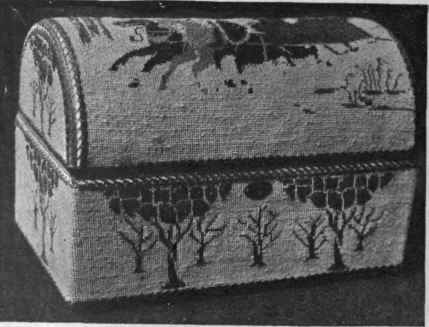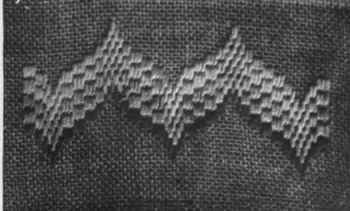2. The Revival Of Needlecraft
Description
This section is from "Every Woman's Encyclopaedia". Also available from Amazon: Every Woman's Encyclopaedia.
2. The Revival Of Needlecraft
Author of "A History of Hand-made Lace." etc.
The Good Done by the Royal School of Art Needlework and other Institutions - A Period" Room should be Upholstered with ** Period " Embroidery Work - The Place of this Class of Work in the Home Life of the Nation - The Italian Revival
The revival in the taste tor needlework of good design and artistic colouring, which has shown itself in so marked a degree since the latter half of the nineteenth century, is due to two things. First, to the establishment of the Royal School of Art Needlework, and, secondly, to the formation of kindred associations, where people in unfortunate circumstances are assisted in helping themselves to earn a livelihood.
Chief amongst these associations is the Working Ladies' Guild, established by Lady Mary Fielding in 1877; bi-annual sales are held, and Princess Henry of Battenberg not only opens these sales, but since her presidency, in 1887, she has presided over a stall in the Decorative Art Department.
The effect of all this practical interest is far reaching, not only in alleviating the poverty of poor gentlewomen, a class the least likely to adopt the clamorous methods of other impecunious classes, but also in raising the standard of amateur needlework.
A very high order of needlecraft is required of the guild members, whether the class be in the art needlework, the plain, or knitting and fancy-work department, and workers are encouraged by special orders, or by suggestion and the lending of patterns, to labour only at articles that are saleable in shape and design.
Many of the embroideries required for the Coronation of King Edward VII. were undertaken by ladies belonging to the guild, amongst the most interesting being the banner which hung in front of Queen Alexandra's seat at Westminster; this has now been converted into a screen, and is in the private apartments at Windsor.
The renewed interest in old furniture, carpets, pictures, and bibelots has been of great service to the appreciation of what is really good in needlework. If our room is furnished in the style of the eighteenth century, then we must have a specimen of petit point or a pole-screen with a floral bouquet in needlework. Chairs of Charles I. and II. require special stitches in crewel-work, Elizabethan embroideries are distinctive, and must appear on hangings used with carved oak. Queen Anne chairs need their special embroideries, and those of the First Empire are revived to place in a room of Napoleonic date in furnishing.

Trunk box for trinkets or jewel-cases worked in petit point in natural coloured wools. Height 10 inches, lined with white satin and bordered with old gold galon

Pole'screen with 18th cen tury embroidered flower panel
With the correct type of old needlework for a particular period, the right accessories are required. Thus, we have bell-ropes with the dainty miniature ribbon-work of Louis XV., and the carved and gilt handle which bears the rococo stamp so legibly; or the bell-rope of correct Jacobean type, where that favourite hunting scene is depicted in the good, firm, vegetable-dyed crewel wools on stout Irish linen. Sound and serviceable bell-pulls both of them, which are of as much use in our electrically fitted houses as are the wrought-iron extinguishers of the link-boys which are to be seen on the old London gates and porticos. Relics of by gone days both, and useless, except as reminders of obsolete customs, but necessary in reproducing the old-world atmosphere.
The old-fashioned square footstool worked in coloured wools on linen is, like other illustrations, designed by Miss Symonds. It shows the old Jacobean hunting scene, and the stag appears - this is the symbol of the hunted human soul whenever found in embroideries of this date. The stag is generally seen, as in this instance, to be standing on the conventionalised waved pattern, which is intended for ground. This convention in ground-making is also freely used in Chinese and Japanese embroideries, and undoubtedly came to us from the East.

Modern Florentine embroidery in three shades of blue on cream canvas
The up-and-down Florentine stitch - so called after some antique examples in a museum in Florence - is harmonious in its softly shaded effect, and is another of the good things brought to us by the revival of needlework; however it is varied, whether the waving is moderate or resembles the temperature chart of a fever patient, the effect is equally good, and the filling a thing of beauty, as in the days of Carpaccio.
Filet, the darning on hand-made net, that is now familiar to everyone, is but one of the beautiful white works which has been revived in this great reawakening of the artistic spirit in needlecraft. One of the earliest forms of openwork ornamentation, it takes its place now with broderie Anglaise in popular favour and in correct execution on the old lines. . The mingling of the two types is strictly correct. Side by side they enriched the pillow beres of the sixteenth century or the counterpanes of the seventeenth; now dainty skirts and blouses are adorned with filet, and the netted insertions are united with broderie Anglaise, which we recognise as the old cut works.

Bell-ropes in ribbon-work of Louis XV. period and Jacobean crewel-work on stout linen

Detail of filet embroidery on hand-made net
Needlecraft is essentially a home industry, to be taken up and put down in the intervals of home-making and home-keeping. Those handicrafts which enable a woman to add to the family exchequer, and at the same time permit her chief work of child-rearing and housekeeping to take their natural course, are desirable from the point of view, not only of private convenience, but also of the far greater importance of national prosperity.
The panacea for many ills, "back to the land," assumes a more practical aspect when the tilling of the soil by the man is assisted by the home industry of the woman.
The hand lace-making centres, such as Devon and Bucks; the cottage button-making counties; the quilters, whose beautiful art has recently been revived; the embroiderers and crochet-working cottagers of Ireland; and the cloth and tweed makers of far-away Harris - what renewed prosperity has come to them all through this revival of needlecraft. Hand-made, hand-sewn, such words are now synonymous with sound workmanship, incompatible with anything shoddy or second-rate.
The story is the same wherever we look. In Italy the once depopulated and starving Island of Burano is now crowded with busy lace stitchers and embroiderers, who own their own cottages, and endow their daughters with the "dot" which makes for happiness.
The simple method of transformation was simple as in England. A few men and women interested themselves in the movement; their tastes were artistic, and they desired the beautiful. Then Royalty lent its patronage, and extended a more practical sympathy. Indeed, by lending Royal embroideries Queen Margherita did much to revive old methods and old patterns.
So the great work of revival goes on; the assistance of clever brains, good organisers, nimble fingers, judicious buyers, and the improvement in taste in other arts and handicrafts, all lend their influence, direct and indirect, in making the twentieth century a real starting-point in the revival of fine needlecraft.
From the highest to those in humbler spheres, all are helping, consciously or unconsciously, to rescue the art of the needle from the depths to which it had fallen. Though it is not given to everyone to execute fine needlework, there are many who, by purchasing it or placing orders with competent Workers, very materially assist in the progress of the revival.
There is one other important point which should be clearly laid before the women home-makers who have the true prosperity of the nation at heart.
Teach your children to sew. If you are unable to do this yourself through press of other work or lack of special knowledge, select a qualified teacher who for at least twenty minutes a day or one hour a week will instruct your daughters in the art of the needle. The practice of plain sewing is needed as a foundation. Only so will the revival of fine needlework continue to thrive in the hands of the coming generation.

Blue linen pincushion worked with drawn thread and lace stitches

Footstool of Jacobean pattern. Hunting scene in coloured wools on linen, 18 inches square
Continue to:


